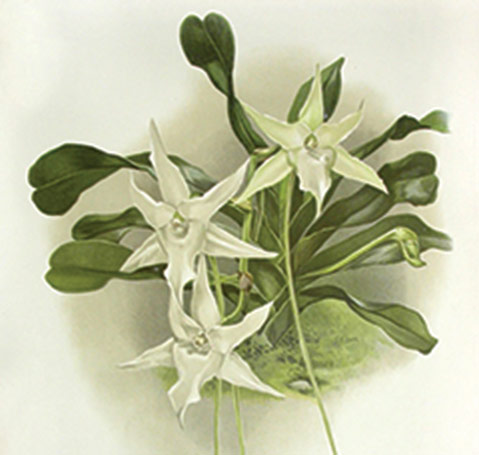Review: Beauty and Science: the orchid evolves
Museum of Natural History Offers Multifaceted Look at Orchid Culture

For thousands of years, the far-flung and diverse family of flowering plants known as orchidaceae has exerted a powerful influence on human culture. From the legendary Orchid Pavilion Gathering in dynastic China, circa 353 CE, to Charlie Kaufman’s 2002 film Adaptation, orchids have been enmeshed with the highest levels of human cultural aspiration. As natural resources for vanilla flavoring, as inspirations for perfume, and as highly sought-after objects in their own right, orchids have attained high value. As the subjects of innumerable experiments in hybridization, as a primary site of scientific research into evolutionary co-adaptation, and as recurring symbols for the sheer extravagance of life, orchids occupy a singular place in the kingdom of flora. This exhibition at the Santa Barbara Museum of Natural History (SBMNH), which was curated by Linda Miller, offers multiple angles from which to view the orchids, all of them engaging, many of them ravishing, and some of them microscopic. Beauty and Science additionally serves as an intelligent and useful introduction to the many facets of the Museum of Natural History as an educational, cultural, and scientific institution.
True orchidmania starts with Victorian imperialism, but Beauty and Science starts a century or more before that, with 18th- and 19th-century botanical plates remarkable for their delicacy and restraint. It’s only when global explorers become orchid bounty hunters that the flowers, and the books that depict them, become oversized big business. For example, take one of Beauty and Science’s showpieces, a copy of The Orchidaceae of Guatemala and Mexico (1837-1843). This magnificent example of fine publishing is a gigantic, gorgeous reference work that’s twice the size of even the biggest coffee-table books. A recent gift to the SBMNH’s extensive and carefully preserved collection, it reflects the passion of James Bateman, master of Knypersley Hall, and the ingenuity of his plant hunter, George Ure Skinner. The majesty of this book reflects a period in which the demand for New World orchids in England was such that in 1878, a single shipment was reported to include more than 2 million plants.
The second section of this intricate presentation concerns the scientific value of orchids in the development of evolutionary theory. Each orchid flower has a structure that’s suited to a specific pollinator, and the investigation of these co-adaptations has proved to be a scientific bonanza, as well as a thrilling example of nature at its most surprising. Butterflies pollinate the orchid known as psychopsis, so its flower mimics the appearance of a female butterfly. Flies like bulbophyllum orchids because they smell like rotting meat. The variation of targets and techniques is mind-boggling.
The final three sections of the show focus on the ways in which botanical science has driven the methods used to picture the orchid. After Linnaeus, illustrators became more sensitive to the functionality of the plant, seeking to define its structure through a schematic approach. In the golden age of Victorian orchidmania, the breeding of hybrid orchids set in motion two distinct forms of orchid science: the breeding of new orchids in greenhouses and the investigation of less well-known wild species of the plant. Dr. Daniel Geiger, the Museum of Natural History’s resident malacologist (that’s the study of shells), is also an orchid gardener, and he participates in ongoing research concerning a relatively rare species, the tiny Thai orchid known as Oberonia or fairy orchid. Geiger uses a scanning electron microscope that was purchased for the museum in 2004 to create spectacular, highly magnified images of the structure of the Oberonia. Thus, the 18th century connects to the 21st in this lively and instructive show.



